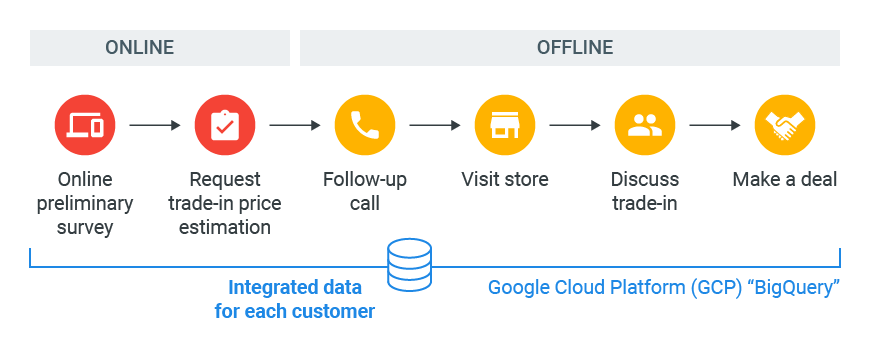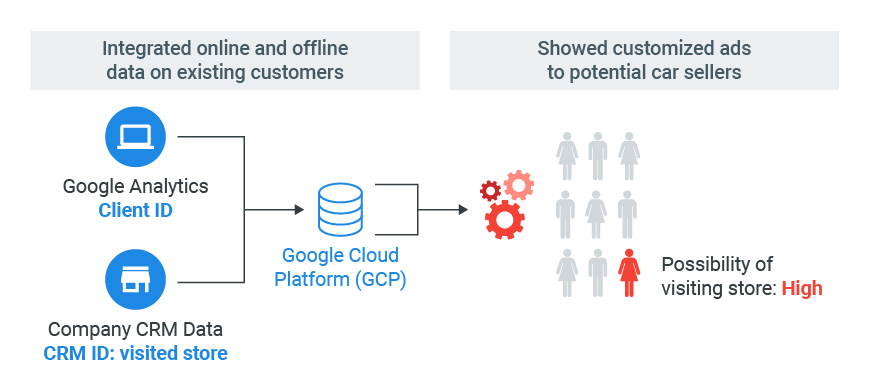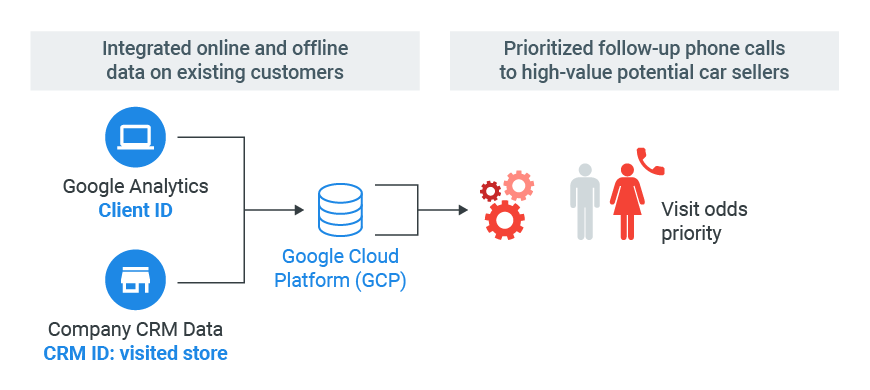IDOM, Japan’s leading buyer and retailer of used cars, looked to attract a new generation of potential sellers to physical stores by finding them where they are: online. IDOM turned to Google Cloud services (powered by machine learning) to better understand the web-to-store customer journey before sellers stepped inside the store to trade in their used cars.
GOALS
Get online customers (prospective car sellers) to visit physical stores
Boost volume of used car acquisitions from sellers
APPROACH
Unified online and offline data to better understand sellers who were more likely to visit a trade-in location
Used Google Cloud services (powered by machine learning) to study data
Followed up via phone with prospective sellers who had requested price estimates for trade-ins and were more likely to visit a store
RESULTS
25% more in-store visits than in previous year
300% increase in sales in a key market segment compared to previous year
Since 1994, IDOM has enjoyed success in the auto industry with a simple yet traditional business model: buy pre-owned vehicles directly from car owners and auction them to third-party dealers or sell them to other consumers at retail stores.
In an increasingly frugal economy, Japanese consumers are buying fewer new cars. Most young urban workers take public transport, a cheap alternative for getting from point A to point B. Additionally, people who do own cars are keeping them longer: the average period of ownership is 7.5 to 10 years.1
Although Japanese consumers are buying fewer new cars, used car sales are steadily on the uptick. Pre-owned car sales in Japan rose by 1.7% in 2015—the first big spike in three years. IDOM dominates this industry with about 40% market share, and it wanted to continue to take advantage of this growing market trend.
To do so, IDOM reinvented its marketing strategy, using Google’s machine-learning technology to make full use of its available customer data. The brand’s main goal was to attract more prospective car sellers to its physical stores because (1) that’s where they could close trade-in deals and (2) sourcing used cars efficiently is integral to the success of its business model.
IDOM embraces every consumer touchpoint along the road
Consider this: 43% of Japanese people own a TV, computer, and smartphone, creating a dizzying array of consumer touch points for Japanese brands. IDOM saw that its customer data was scattered across many online and offline channels, resulting in a fragmented snapshot of prospective car sellers and buyers.
A seismic shift from per-channel to per-user thinking
With so many links across systems, IDOM found itself wasting time with costly data analysis. To resolve this problem, IDOM used Google Cloud Platform to unify online data (as when a potential car seller requested a trade-in price estimate online) with offline data (as when that same person visited a trade-in location to sell his or her car), resulting in a clearer snapshot of each customer. Doing so helped IDOM uncover trackable insights into each unique car seller that previously fell through the cracks.

Brand strategy completely rebuilt on machine learning
Based on web traffic and store visit data in its CRM system that were stored in BigQuery, IDOM—with the aid of Google Cloud Platform, Google Ads,2 and Google Analytics 360—analyzed a number of user signals to uncover and reach users whose online activity resembled that of users who had previously visited its stores to discuss trade-in deals. IDOM also used Google Analytics to monitor trends and identify users who were more likely to visit a store, which helped the brand prioritize these prospective sellers for follow-up calls.
The process looked like this:


Evaluating marketing on profit instead of performance
Rather than measure marketing success solely on clicks, views, brand awareness, or favorability, IDOM relied on data to determine which advertising techniques—including phone calls and customized ads to prospective sellers—turned a real profit. After successfully identifying and targeting existing car owners with a high chance of selling their car, it was only natural for IDOM to leverage this approach to identify and target potential customers with a higher chance of buying a car—key for the other side of its business as well. Thus, IDOM also showed customized ads to potential car buyers and prioritized follow-up phone calls to high-value potential car buyers.
Machine learning and automation saves IDOM time and empowers digital talent
Powered by machine learning, IDOM’s campaign converted online customer interest into boots-on-the-ground store visits, increasing the number of sellers and buyers visiting its stores by a whopping 25% compared to the previous year. Furthermore, gross profits increased by 300% in a key market segment compared to the previous year.
Automation enabled employees who had previously spent time analyzing data to focus on more valuable work, such as store service planning. Staff members could launch new services projects and start new lines of business, including Social Assessment, where used car sellers can get a quick and easy estimate online; NOREL, a monthly subscription rental service; and Car Sale Planner, a robust, customer-centric tool for trade-ins.
No matter how much data you have, if it’s scattered across multiple channels, truly understanding customer needs is impossible.
“No matter how much data you have, if it’s scattered across multiple channels, truly understanding customer needs is impossible. Thankfully, Google allowed us to learn more about each user and get a holistic view of our audience. With these products, marketers can analyze and act on rather than just collect data,” concluded Noboru Kitajima, operating officer at IDOM.






